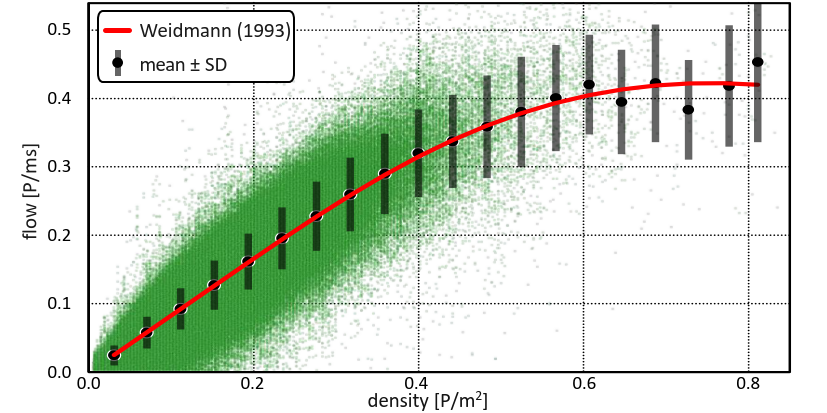Estimating the Capacity of Railway Platforms and Stations
DOI:
https://doi.org/10.17815/CD.2024.158Keywords:
Fundamental diagram, Tracking, Railway stationAbstract
Knowing the capacity and the speed-density relation for different facility parts is a key component for a sustainable station design. But as the behaviour of pedestrians on railway platforms is complex, detailed data from railway stations is needed, which only became available recently. By using real-life tracking data from different railway stations in Switzerland, a method to estimate the capacity for different facility elements was derived and applied to the data aiming at verifying or improving the existing design values.
As expressed in the fundamental diagram, the speed-density relation was useful in addressing these issues. The speed-density-flow relation was plotted at different levels ranging from a whole platform section to areas covering only a few square meters. Waiting pedestrians were treated separately to reflect their specific behaviour. Afterwards, the Kladek-curve proposed by Weidmann was fitted to the data using different parameter values. Although the data is biased towards low densities, the capacity of each area can be estimated using the fitted curve.
The results show that the flow-density curves show a good fit to the mean of each density bin. Nevertheless, a large scatter of the individual data points exists. The derived maximum flow is considerably different depending on the measurement location and the area size and is generally lower than average values from literature. It is expected that the complex behaviour of pedestrians in railway stations and platforms has a significant influence on these differences, which therefore needs to be considered for station design.
References
Bosina, E.: A New Generic Approach to the Pedestrian Fundamental Diagram. Doctoral Thesis, ETH Zurich (2018). doi:10.3929/ethz-b-000296226
Bosina, E., Weidmann, U.: Defining the pedestrian fundamental diagram. In: Hamdar, S.H. (ed.) Traffic and Granular Flow '17, pp. 383-391. Springer International Publishing, Cham (2019). doi:10.1007/978-3-030-11440-4_42
Daamen, W., den Heuvel, J.v., Knoop, V.L., Hoogendoorn, S.P.: Macroscopic Fundamental Diagram for Train Platforms. In: Hamdar, S.H. (ed.) Traffic and Granular Flow '17, pp. 365-372. Springer International Publishing, Cham (2019). doi:10.1007/978-3-030-11440-4_40
Thurau, J., Keusen, N.: Influence of Obstacles on the Use of the Danger Zone on Railway Platforms. Collective Dynamics 5, A84 (2020). doi:10.17815/CD.2020.84
Küpper, M., Seyfried, A.: Analysis of Space Usage on Train Station Platforms Based on Trajectory Data. Sustainability 12(20), 8325 (2020). doi:10.3390/su12208325
Weidmann, U.: Transporttechnik der Fussgänger - Transporttechnische Eigenschaften des Fussgängerverkehrs. No. 90 in Schriftenreihe des IVT. Institut für Verkehrsplanung, Transporttechnik, Strassen- und Eisenbahnbau, ETH Zürich, Zürich (1993). doi:10.3929/ethz-b-000242008

Downloads
Published
How to Cite
Issue
Section
Categories
License
Copyright (c) 2024 Ernst Bosina, Raphael Roth, Jonas Meli

This work is licensed under a Creative Commons Attribution 4.0 International License.
Authors contributing to Collective Dynamics agree to publish their articles under the Creative Commons Attribution 4.0 license.
This license allows:
Share — copy and redistribute the material in any medium or format
Adapt — remix, transform, and build upon the material
for any purpose, even commercially.
The licensor cannot revoke these freedoms as long as you follow the license terms.
Authors retain copyright of their work. They are permitted and encouraged to post items submitted to Collective Dynamics on personal or institutional websites and repositories, prior to and after publication (while providing the bibliographic details of that publication).








